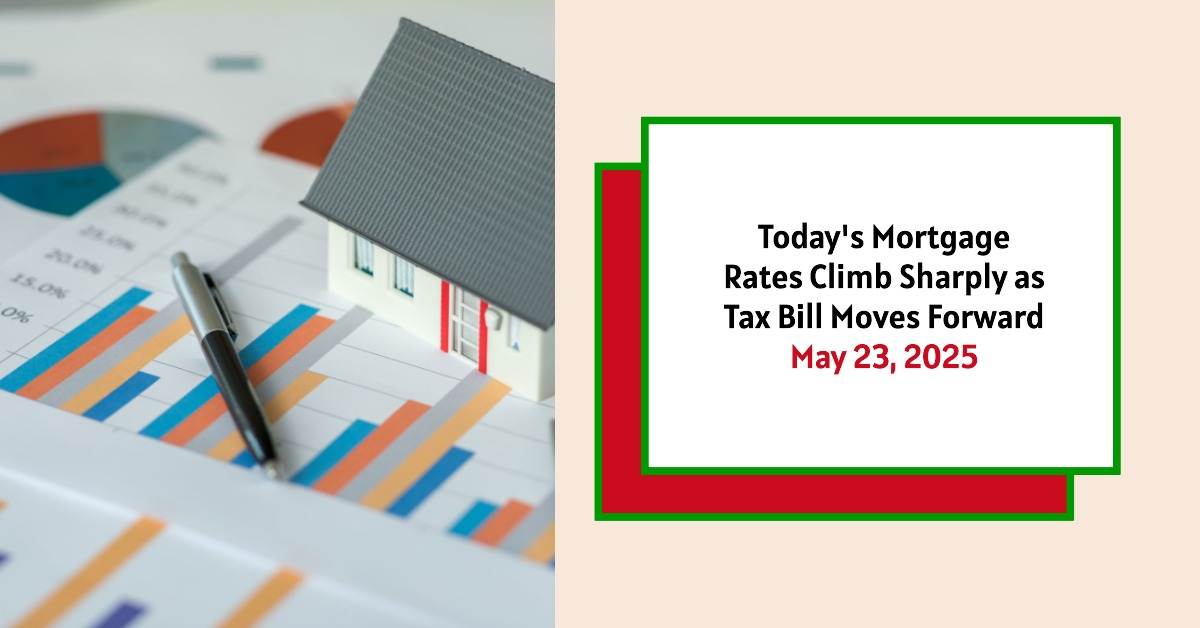Mortgage rates on May 23, 2025, have seen a notable increase compared to previous weeks, marking the third consecutive week of rising interest rates. According to Freddie Mac, the weekly national average for a 30-year fixed mortgage is currently at 6.86%, while the average for a 15-year fixed mortgage stands at 6.01%. While these rates represent a slight uptick, they remain lower than they were a year ago, providing some relief to potential buyers amid an otherwise challenging market.
However, mortgage rates have also climbed to their highest point in over a month as investors react to concerns about U.S. credit risk and the potential for a widening budget deficit. Contributing factors include the recent downgrade to the U.S. credit rating and anticipated increases to the deficit stemming from tax policy. These concerns are driving demand for higher yields on the 10-year Treasury, which in turn impacts mortgage rates. Significant improvement in mortgage rates this year likely hinges on signs of a softening labor market.
Today's Mortgage Rates – May 23, 2025: Rates Climb Higher as Tax Bill Moves Forward
Key Takeaways
- Today's Rates: 30-year fixed at 6.96%, 15-year fixed at 6.12%.
- Trend: Rates have increased for three weeks straight.
- Comparison to Previous Year: Both types of loans are lower than this time last year.
- Market Context: Investor concerns about U.S. credit risks are influencing these rates.
- Future Outlook: Predictions suggest rates may stabilize but not drop significantly this year.
Current Mortgage Rates Overview
According to Zillow, as of May 23, 2025, the mortgage and refinance rates in the U.S. are as follows:
- 30-year fixed: 6.96%
- 20-year fixed: 6.79%
- 15-year fixed: 6.12%
- 5/1 ARM: 7.61%
- 7/1 ARM: 7.58%
- 30-year VA: 6.49%
- 15-year VA: 5.79%
- 5/1 VA: 6.35%
Additionally, for those considering refinancing, here are the current national averages:
| Refinance Type | Rate (%) |
|---|---|
| 30-year Fixed | 7.07 |
| 20-year Fixed | 6.58 |
| 15-year Fixed | 6.08 |
| 5/1 ARM | 7.91 |
| 7/1 ARM | 7.68 |
| 30-year VA | 6.53 |
| 15-year VA | 6.13 |
| 5/1 VA | 6.31 |
It’s worth noting how fluctuations in rates can impact different borrowers. Traditionally, refinancing rates tend to be slightly higher than those for purchasing new homes, but this can vary based on individual circumstances, like loan-to-value ratios and credit scores. Higher refinance rates may deter some homeowners from opting for a refinance, especially if they secured a lower rate previously.
How Mortgage Interest Rates Work
Understanding how mortgage interest rates work is fundamental for anyone considering buying or refinancing a home. Mortgage rates are essentially the costs associated with borrowing money to finance a home, expressed as a percentage.
- Fixed-Rate Mortgages:
- A fixed-rate mortgage locks in a consistent interest rate for the entire duration of the loan. For example, if you secure a 30-year mortgage at 6%, that rate remains constant for the full term unless you choose to refinance.
- Adjustable-Rate Mortgages (ARMs):
- ARMs offer an initial lower interest rate, which can then change at specified intervals based on market conditions. For instance, with a 7/1 ARM, you enjoy a fixed rate for the first seven years, with subsequent adjustments happening annually thereafter. This can be advantageous if you plan to sell or refinance before the rate adjusts.
A unique aspect of mortgages is how payments are structured. In the early years of the loan, your payments mainly cover interest rather than the principal amount borrowed. Over time, however, a greater portion of your monthly payment goes towards the principal, building equity in your home.
What’s Driving Mortgage Rates Up?
The recent increase in mortgage rates can be attributed to various economic factors, which broadly influence both borrower costs and investor behavior.
- Investor Sentiment: Investors are closely monitoring the U.S. credit rating and the potential for budget deficits. Concerns surrounding economic growth can lead investors to seek higher returns on Treasury bonds, directly affecting mortgage rates.
- Federal Reserve Policies: The Federal Reserve plays a crucial role in influencing interest rates by adjusting monetary policy in response to economic conditions. If economic indicators show inflation or growth concerns, the Fed may decide to maintain or increase interest rates, which impacts mortgage rates directly.
- Labor Market Dynamics: A robust labor market typically exerts upward pressure on mortgage rates. Strong employment figures can lead to wage growth, sparking inflation fears. Conversely, if the labor market shows signs of cooling (for instance, rising unemployment rates), this could prompt a decrease in mortgage rates as investors flock to safer assets.
Read More:
Mortgage Rates Trends as of May 22, 2025
Dave Ramsey Predicts Mortgage Rates Will Probably Drop Soon in 2025
Future of Mortgage Rates Post-Fed Decision: Will Rates Drop?
Fed's Decision Signals Mortgage Rates Won't Go Down Significantly
Assessing Future Outlooks
Looking ahead, a multitude of factors could influence mortgage rates throughout 2025. According to forecasts from Fannie Mae and the Mortgage Bankers Association, both groups expect mortgage rates to settle around 6.5% to 6.8% for the remainder of the year.
Here’s a closer look at the projected quarterly rates for the common 30-year fixed-rate mortgages:
| Forecaster | Q2/25 | Q3/25 | Q4/25 | Q1/26 |
|---|---|---|---|---|
| Fannie Mae | 6.5% | 6.3% | 6.2% | 6.1% |
| MBA | 7.0% | 6.8% | 6.7% | 6.6% |
Fannie Mae’s outlook indicates a more cautious approach, anticipating gradual improvements. In contrast, the MBA’s slightly higher expectations reflect optimism that market conditions will stabilize in favor of prospective buyers.
Understanding the Broader Economic Impacts
The implications of rising mortgage rates extend beyond individual borrowing costs. Firstly, if fewer individuals can afford to buy homes due to increasing mortgage rates, there could be a slowdown in housing market activity. This reduction in homebuying may lead to lower demand for housing, affecting related sectors like construction, real estate, and home goods.
Furthermore, if home sales decline, new construction may slow, which can lead to job losses in the construction sector and affect suppliers of building materials. As fewer homes are sold, fewer consumers will purchase related goods—everything from appliances to landscaping services—causing further ripple effects throughout the local economy.
Conversely, a stabilizing housing market can yield advantages for prospective buyers. With inventory levels improving, homebuyers may find a broader selection of properties, potentially improving their negotiating power. In addition, the “lock-in effect” may begin to cool as more homeowners opt to list their properties despite earlier low mortgage rates, contributing to a healthier market equilibrium.
Conclusion
Today's housing market, characterized by shifting mortgage rates, demands informed and adaptable strategies for homebuyers and those considering refinancing. While the relationship between economic factors, market sentiment, and mortgage rates can be complex, understanding these dynamics empowers you to make sound financial decisions.
Despite the challenges, current conditions also present opportunities. While rates are higher than recent lows, they remain competitive compared to last year, potentially making homeownership more attainable than you might think.
In a market where timing and rates significantly impact your financial well-being, knowledge is key. Whether you're buying or refinancing, being well-informed is crucial for securing the best possible outcome.
Invest Smarter in a High-Rate Environment
With mortgage rates remaining elevated this year, it's more important than ever to focus on cash-flowing investment properties in strong rental markets.
Norada helps investors like you identify turnkey real estate deals that deliver predictable returns—even when borrowing costs are high.
HOT NEW LISTINGS JUST ADDED!
Connect with a Norada investment counselor today (No Obligation):
(800) 611-3060
Also Read:
- Will Mortgage Rates Go Down in 2025: Morgan Stanley's Forecast
- Expect High Mortgage Rates Until 2026: Fannie Mae's 2-Year Forecast
- Mortgage Rate Predictions 2025 from 4 Leading Housing Experts
- Mortgage Rates Forecast for the Next 3 Years: 2025 to 2027
- 30-Year Mortgage Rate Forecast for the Next 5 Years
- 15-Year Mortgage Rate Forecast for the Next 5 Years
- Why Are Mortgage Rates Going Up in 2025: Will Rates Drop?
- Why Are Mortgage Rates So High and Predictions for 2025
- Will Mortgage Rates Ever Be 3% Again in the Future?
- Mortgage Rates Predictions for Next 2 Years
- Mortgage Rate Predictions for Next 5 Years
- Mortgage Rate Predictions: Why 2% and 3% Rates are Out of Reach
- How Lower Mortgage Rates Can Save You Thousands?
- How to Get a Low Mortgage Interest Rate?
- Will Mortgage Rates Ever Be 4% Again?



